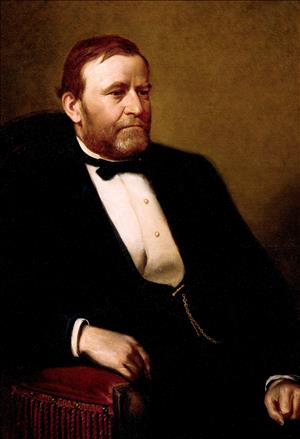On September 20, 1852, Ulysses S. Grant (1822-1885), then a 30-year-old Brevet Captain, later a famed Civil War general and United States President, arrives with the 4th Infantry regiment at Columbia Barracks, a U.S. Army base on the Columbia River. The base, later called Fort Vancouver and then Vancouver Barracks, is located next to the Hudson’s Bay Company’s Fort Vancouver trading post, within the present-day city of Vancouver, Clark County. Grant spends the next 15 months as regimental quartermaster at the base.
Captain Grant’s 4th Infantry regiment left Benicia, California, where it had been stationed for several months, on September 14, 1852, in the steamer Columbia and arrived at Columbia Barracks on September 20, 1852. The army had established the base in 1849, at the site of the existing Hudson’s Bay Company post, strategically located on the north bank of the Columbia a few miles above the mouth of the Willamette River on the opposite side. Situated on a fertile prairie above the river, with sweeping views of the river, forests, and mountains, the base was an agreeable posting for Grant.
Along with two other officers and some clerks, Grant lived in "Quartermaster’s Ranch," an imposing, two-story home with high ceilings and a porch on three sides, which was prefabricated in New England and shipped around Cape Horn in sections. It was the finest building on the base, and in Grant’s opinion in all of Oregon Territory. Even the base commander lived in a chinked log cabin, while the home of Grant and his fellow officers became the base’s social center. Contrary to legend, Grant did not actually live in the log structure called the "Grant House," which is now a museum at the Fort Vancouver National Historical site, although he spent time there since it was the regimental headquarters.
In addition to his quartermaster’s duties, Grant spent his days playing cards and socializing with fellow officers, and taking long horseback rides along the Columbia, and down the Willamette to Portland and Oregon City. In January 1853, he and his friend Captain Rufus Ingalls were the first of the season to walk across the frozen Columbia River. Grant enjoyed the Northwest, and would have liked to have his family, which consisted then of his wife Julia and two sons, join him. However, the cost of living in the region was too high to maintain a family on his army salary.
Like many soldiers of his day, Grant attempted to go into business for himself on the side. However, in a pattern that would be repeated throughout his life, the business ventures he entered with fellow officers proved to be failures despite his high expectations for them. The officers cut ice on the Columbia and shipped it to San Francisco for sale, but it melted before arrival. They rounded up cattle and pigs to ship to San Francisco, but lost money on the enterprise. They leased land and started a farm, but a river flood wiped out most of the crops. They rented space in a San Francisco hotel to run a billiard club, but the manager they hired absconded with their money.
In early 1854, Grant was transferred from Fort Vancouver and assigned to Fort Humboldt in northern California. Within a few months, he resigned from the army. He did not serve again until the Civil War broke out. During his 15 months in the Northwest, both Grant and the region underwent changes. In March 1853, while Grant was stationed there, Washington Territory was created from the portion of Oregon Territory north of the Columbia River. And in the first letter he wrote his wife from the newly created Territory, Grant reported on his growing beard, which he had started when he left California, and which would characterize his appearance for the remainder of his life.

